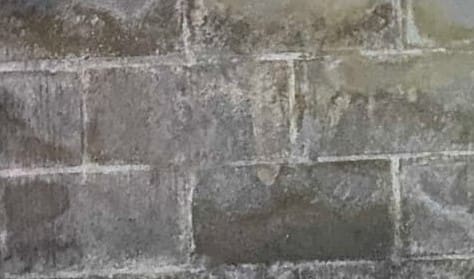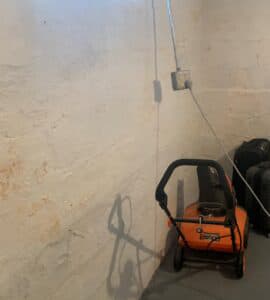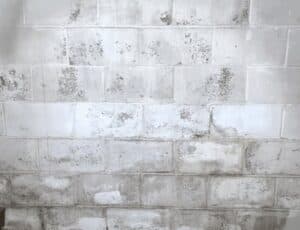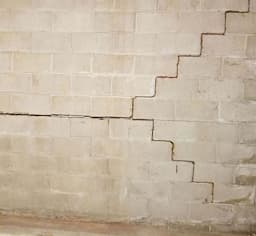3 Signs Of Moisture Damage (That Aren’t Water)

Everyone knows that water flooding into your basement is an issue. But water intrusion isn’t always “in your face.” Sometimes, water seeps into your basement walls or floor, then dries up before anyone sees it.
Acculevel is a family-owned and operated company that specializes in waterproofing and foundation repair. Since we opened our doors in 1996, we’ve helped more than 35,000 homeowners restore strength and health to their homes. We have seen many buildings with moisture or water damage that went undetected until significant (and expensive) repairs were needed.
In this article, we’re going to explain the three primary ways you can detect moisture damage in your basement- even if you never see any actual water leaking into your home.
Efflorescence is a Sign of Previous Water Intrusion
You may be thinking, “well that’s great, but what in the Sam Hill is efflorescence?” When moisture creeps through concrete, then dries, it leaves behind a residue. Efflorescence is the residue left behind; it’s evidence of water evaporation.
This residue is created by the mineral deposits that were in the water. What’s left on the wall or floor will have a grainy texture like salt crystals. Efflorescence can be different colors, depending on the minerals in the water. In the picture below, the staining is brown because the water has a high iron content.

This photo was taken by an Acculevel project advisor during a free in-home evaluation. There is some pale brown discoloration on the basement walls; this is efflorescence.
In many cases, efflorescence is white, so you’re more likely to see or feel texture, more than color. If your basement walls haven’t been painted, you’re more likely to see white or pale gray residue.

An Acculevel project advisor took this photo, also.
Efflorescence is unattractive, but harmless. It’s only a cause for concern because it is evidence of moisture damage taking place inside your foundation.
How Do You Treat Efflorescence?
The first step is going to be dealing with the moisture or water that is seeping in. This could require a full basement waterproofing system, or just a whole-home dehumidifier.
Once the source of the moisture is eliminated or controlled, you can use a bristle brush to remove the efflorescence. If the color stains the wall, you will probably need to paint over it.
Biological Growth Is A Sign Of Moisture Intrusion
We’re using “biological growth” as a blanket term to cover all sorts of unwanted visitors: mold, mildew, bacteria, viruses, etc. These microscopic organisms are everywhere. You can pick them up on your clothes as you walk outdoors, bring them home in a gym bag, or let them in when you open a door or window.
Not only are they prolific, but they’re also easy to please. Biological growth likes dark places, and it only requires two things to thrive: a source of food, and a source of water. For mold and its friends, food can be dust, shedded skin cells, or many other types of tiny debris. Likewise, biological growth only needs a bit of moisture. For many varieties, condensation on a humid day is enough moisture to create a problem.

This photo was taken by an Acculevel project advisor during a free in-home assessment. This basement wall has gray-black mold growing on it.
Unlike efflorescence, biological growth is a cause for significant concern. Even in healthy adults, mold can have unpleasant side effects. It’s a common allergen, and a serious threat to anyone with respiratory ailments like asthma.
How Do You Deal With Biological Growth?
We review important facts, and debunk some myths about mold, in this article. If the mold covers an area larger than 10 square feet, the EPA (Environmental Protection Agency) recommends that you contact a professional for remediation services. You can learn more about our mold treatment options, methods, and costs here.
Cracks In Your Basement Walls Can Be A Sign of Water Damage
There is a range of foundation crack types, and not all of them involve water. Extremely thin cracks (often called hairline cracks) are caused by seasonal weather changes. Concrete experiences some contraction when the ground freezes, and when it thaws, your foundation can expand a bit. While it’s possible for hairline cracks to let in water, it’s not typical.
Wider Foundation Cracks Allow Water Intrusion
In the previous sections, we’ve referenced that water can seep in through concrete walls and evaporate before you notice it. This can be enough moisture to create efflorescence or feed mold.
Over time, this water seepage will gradually erode the concrete until it becomes weak enough to crack. Water is practical- once it’s found a way through your foundation wall, it will keep returning to this weakened spot. When this process continues for long enough, the water “eats away” at the wall and creates cracks. This is often how water intrusion happens.

This is another photo taken by an Acculevel project advisor, during a free in-home evaluation. Water is entering the basement through this crack.
How Do You Repair Thin Foundation Cracks?
If there’s a crack in your foundation that looks like this -even if it’s not letting in water- you need to have it repaired. Sooner or later, it will become a serious threat. For thinner cracks like the one above, we believe epoxy fill is the best crack repair method.
Over time, this type of narrow crack will widen, letting larger amounts of water intrude. It may also be joined by more cracks, causing more substantial basement flooding and even foundation damage.
Foundation Cracks Are A Serious Threat To Your Home
If you have other shapes of foundation cracks in your basement, you need to take action promptly. These can be long horizontal cracks or stair step (zig zag) patterned cracks. You can see both in the image below.

This photo was taken by an Acculevel project advisor during a home assessment. The wall is badly cracked and beginning to bow inward.
If you see any cracks like these inside your basement, you need to find a foundation repair expert- and quickly. Walls that bow or buckle inward will keep moving, until they collapse. Since this article is focused on moisture damage, we’re not going to cover this topic in detail. You can learn more about foundation cracks, bowing walls, and repair methods here.
Do You Have More Questions About Basement Waterproofing?
Even if you don’t live in the Midwest, our *free* basement waterproofing guide has plenty to offer! You can learn more about the components of waterproofing, their purposes, costs, installation method, and the answers to frequently asked questions:
Need A Waterproofing Expert to Evaluate Your Home?
If you live within our service area (Indiana and portions of the surrounding states), call Acculevel. One of our knowledgeable and experienced project advisors will come to your home, meet with you, and perform a comprehensive assessment of your house.
Our goal is to provide every homeowner with a whole-home solution; this is a repair plan that solves the problems you’ve noticed as well as any underlying causes that need to be addressed.
Do you work third shift? Hate talking on the phone? Prefer written communication? Contact us through our online form and let us know the best way to contact you.
If you aren’t lucky enough to live in the Hoosier state or the surrounding areas, please make sure any contractor you work with is properly insured and accredited by the Better Business Bureau.
